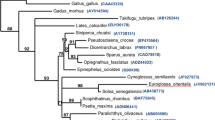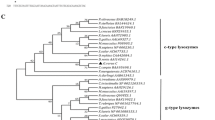Abstract
The gene coding for lysozyme in banana prawn (Fenneropenaeus merguiensis) was cloned, sequenced and expressed in pET-32a vector. The deduced amino acid sequence of F. merguiensis lysozyme showed 37–93% similarity with the mouse, human, chicken, and tiger prawn counterparts. The lysozyme was purified to homogeneity and observed as a band of approximately 15 kDa in 12% SDS-PAGE. Semiquantitative RT-PCR analysis demonstrated that mRNA transcripts of lysozyme could be mainly detected in the tissues of hemocytes, gill, gonad and lymphoid organ of unchallenged shrimps, whereas the expression of lysozyme transcripts was increased in all the tested tissues after heat-killed Vibrio alginolyticus challenge. The temporal expression of lysozyme mRNA in hemolymph challenged by Micrococcus luteus and V. alginolyticus was both up-regulated and reached the maximum level at 8 and 16 h post stimulation, respectively, and then dropped back to the original level. Bacteriolytic activity of lysozyme against different bacterial cultures was determined by solid phase as well as turbidimetric assay. Lysis was obtained against Gram positive and Gram negative bacteria with strong inhibition against shrimp pathogens V. alginolyticus and V. parahemolyticus. In addition, the study of inhibition mechanism revealed that the antibacterial activity of lysozyme was a result of bactericidal effect.









Similar content being viewed by others
References
Bachali S, Jager M, Hassanin A, Schoentgen F, Jollès P, Fiala-Medioni A, Deutsch JS (2002) Phylogenetic analysis of invertebrate lysozymes and the evolution of lysozyme function. J Mol Evol 54:652–664. doi:10.1007/s00239-001-0061-6
Bu XJ, Du XJ, Zhou WJ, Zhaoa XF, Wang JX (2008) Molecular cloning, recombinant expression, and characterization of lysozyme from Chinese Shrimp Fenneropenaeus chinensis. Chin J Biotechnol 24(5):723–732. doi:10.1016/S1872-2075(08)60037-0
Burge EJ, Madigan DJ, Burnett LE, Burnett KG (2007) Lysozyme gene expression by hemocytes of Pacific white shrimp, Litopenaeus vannamei, after injection with Vibrio. Fish Shellfish Immunol 22:327–339. doi:10.1016/j.fsi.2006.06.004
Canfield RE (1963) The amino acid sequence of egg white lysozyme. J Biol Chem 238:2698–2707
de-la-Re-Vega E, García-Galaz A, E. Díaz-Cinco M, Sotelo-Mundo RR (2006) White shrimp (Litopenaeus vannamei) recombinant lysozyme has antibacterial activity against Gram negative bacteria: Vibrio alginolyticus, Vibrio parahemolyticus and Vibrio cholerae. Fish Shellfish Immunol 20:405–408
de Lorgeril J, Saulnier D, Janech MG, Gueguen Y, Bachère E (2005) Identification of genes that are differentially expressed in hemocytes of the Pacific blue shrimp (Litopenaeus stylirostris) surviving an infection with Vibrio penaeicida. Physiol Genomics 21:174–183
FAO (2006) Fishstat Plus: Universal software for fishery statistical. Time Series 1950–2004. Version 2.30. FAO Fisheries Department, Fishery Information, Data and Statistics Unit. http://www.fao.org/fi/statist/fisoft/FISHPLUS.asp
Fujiki K, Shin DH, Nakao M, Yano T (2000) Molecular cloning of carp (Cyprinus carpio) leucocyte cell-derived chemotaxin 2, glia maturation factor b, CD45 and lysozyme C by use of suppression subtractive hybridization. Fish Shellfish Immunol 10:643–650
Gao FY, Ye X, Bai JJ, Lao HH, Wu RQ (2005) cDNA cloning and expression characterization of lysozyme gene in two freshwater prawn. Acta Hydrobiol Sin 29(6):615–620
Goarant C, Merien F, Berthe F, Mermoud I, Perolat P (1999) Arbitrarily primed PCR to type Vibrio spp. pathogenic for shrimp. Appl Environ Microbiol 65:1145–1151
Grütter MG, Weaver LH, Matthews BW, Grütter MG (1983) Goose lysozyme structure: an evolutionary link between hen and bacteriophage lysozymes? Nature 303:828–831
Hikima S, Hikima J, Rojtinnakorn J, Hirono I, Aoki T (2003) Characterization and function of kuruma shrimp lysozyme possessing lytic activity against Vibrio species. Gene 316:187–195
Hoang T (2001) The banana prawn—the right species for shrimp farming? World Aquac 32(4):40–44
Ibrahim HR, Yamada M, Kobayashi K, Kato A (1992) Bactericidal action of lysozyme against Gram-negative bacteria due to insertion of a hydrophobic pentapeptide into its C-terminus. Biosci Biotechnol Biochem 56:1361–1363
Ibrahim HR, Yamada M, Matsushita K, Kobayashi K, Kato A (1994) Enhanced bactericidal action of lysozyme to Escherichia coli by inserting a hydrophobic pentapeptide into its C terminus. J Biol Chem 269:5059–5063
Ito Y, Yoshikawa A, Hotani T, Fukuda S, Sugimura K, Imoto T (1999) Amino acid sequences of lysozymes newly purified from invertebrates imply wide distribution of a novel class in the lysozyme family. Eur J Biochem 259:456–461
Jollés P, Jollés J (1984) What’s new in lysozyme research? Always a model system, today as yesterday. Mol Cell Biochem 63:165–189
Krieg NR, Gerhardt P (1994) Solid, liquid/solid, and semisolid culture. In: Gerhardt P, Murray RGE, Wood WA, Krieg NR (eds) Methods for general and molecular bacteriology, vol 32. American Society of Microbiology, USA, pp 216–223
Laemmli UK (1970) Cleavage of structural proteins during the assembly of bacteriophage T4. Nature 227:680–685
Lightner DV (1996) A handbook of shrimp pathology and diagnostic procedures for disease of cultured penaeid shrimp. World Aquaculture Society, Baton Rouge, LA, USA
Loongyai W, Avarre JC, Cerutti M, Lubzens E, Chotigeat W (2007) Isolation and functional characterization of a new shrimp ovarian peritrophin with antimicrobial activity from Fenneropenaeus merguiensis. Mar Biotechnol 9:624–637
Milochau A, Lassegues M, Valembois P (1997) Purification, characterization and activities of two hemolytic and antibacterial proteins from coelomic fluid of the annelid Eisenia fetida andrei. Biochem Biophys Acta 1337:123–132
Muñoz M, Vandenbulcke F, Saulnier D, Bachère E (2002) Expression and distribution of penaeidin antimicrobial peptides are regulated by haemocyte reactions in microbial challenged shrimp. Eur J Biochem 269:2678–2689
Nicholas KB, Nicholas HB (1997) GENEDOC: a tool for editing and annotating multiple sequence alignments. http://www.cris.com/~ketchup/genedoc.shtml
Nilsen IW, Rverbr K, Sandsdalen E, Sandaker E (1999) Protein purification and gene isolation of chlamysin, a cold-active lysozyme-like enzyme with antibacterial activity. FEBS Lett 464:153–58
Nilsen IW, Myrnes B, Edvardsen RB, Chourrout D (2003) Urochordates carry multiple genes for goose-type lysozyme and no genes for chicken- or invertebrate-type lysozymes. Cell Mol Life Sci 60:2210–2218
Nitta K, Sugai S (1989) The evolution of lysozyme and a-lactalbumin. Eur J Biochem 182:111–118
Prager EM, Jollès P (1996) Animal lysozymes c and g: an overview. In: Jollès P (ed) Lysozymes: model enzymes in biochemistry and biology. Birkhäuser Verlag, Basel
Rittidacha W, Paijita N, Utarabhand P (2007) Purification and characterization of a lectin from the banana shrimp Fenneropenaeus merguiensis hemolymph. Biochem Biophys Acta 1770(1):106–114
Sotelo-Mundoa RR, Islas-Osuna MA, de-la-Re-Vega E, Hernández-López J, Vargas-Albores F, Yepiz-Plascencia G (2003) cDNA cloning of the lysozyme of the white shrimp Penaeus vannamei. Fish Shellfish Immunol 15:325–331
Shugar D (1952) The measurement of lysozyme activity and the ultra-violet inactivation of interferon. Biochem Biophys Acta 8:302–309
Simpson RJ, Begg GS, Dorow DS, Morgan FJ (1980) Complete amino acid sequence of the goose-type lysozyme from the egg white of the black swan. Biochemistry 19:1814–1819
Sotelo-Mundo RR, Islas-Osuna MA, de-la-Re-Vega E, Hernandez-Lopez J, Vargas-Albores F, Yepiz-Plascencia G (2003) cDNA cloning of the lysozyme of the white shrimp Penaeus vannamei. Fish Shellfish Immunol 15:325–331
Swofford DL (2002) PAUP*, Phylogenetic Analysis Using Parsimony (*and other methods), Version 4. Sinauer Associates, Sunderland, MA
Thompson JD, Higgins DG, Gibson TJ (1997) Clustal W: improving the sensitivity of progressive multiple sequence weighting, position-specific gap penalties and weight metric choices. Nucleic Acids Res 22:4673–4680
Thunnissen AMWH, Isaacs NW, Dijkstra BW (1995) The catalytic domain of a bacterial lytic transglycosylase defines a novel class of lysozymes. Proteins 22:245–258
Ting KL, Jernigan RL (2002) Identifying a folding nucleus for the lysozyme/a-lactalbumin family from sequence conservation clusters. J Mol Evol 54:425–436
Touch V, Hayakawa S, Saitoh K (2004) Relationships between conformational changes and antimicrobial activity of lysozyme upon reduction of its disulfide bonds. Food Chem 84:421–428
Acknowledgement
We acknowledge the help of Youhou Xu, Lifeng Wu and Peng Luo in running this experiment. This work was supported by the National High Technology Development Project of China under contract no. 2006AA10A406.
Author information
Authors and Affiliations
Corresponding author
Rights and permissions
About this article
Cite this article
Mai, Wj., Hu, Cq. Molecular cloning, characterization, expression and antibacterial analysis of a lysozyme homologue from Fenneropenaeus merguiensis . Mol Biol Rep 36, 1587–1595 (2009). https://doi.org/10.1007/s11033-008-9355-8
Received:
Accepted:
Published:
Issue Date:
DOI: https://doi.org/10.1007/s11033-008-9355-8




